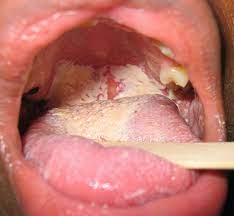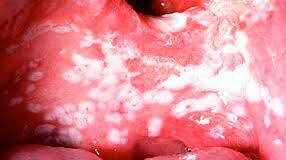Thrush Treatment: Effective Solutions for Oral and Vaginal Thrush
Thrush infection or (yeast infection) is a fungal infection caused by the Candida albicans fungus that can occur in babies. Thrush is manifested by the presence of white patches in the baby’s mouth that can spread to the mother’s breast It is a common problem that can cause discomfort, pain and irritation in the mouth and throat areas. Thrush can appear as white patches on the tongue, inside of the cheeks and the roof of the mouth, and may be accompanied by a sore throat, fever, and difficulty swallowing. If left untreated, thrush can spread to other areas of the body, such as the diaper area, and cause serious health issues. Treatment for thrush includes antifungal medications and topical creams, as well as dietary and lifestyle changes. Please keep reading for details on the following topics:
Cause of thrush
How thrush is spread
Symptoms of thrush
Treatment of thrush
How to prevent thrush

CAUSE OF THRUSH
The cause of thrush is a fungal infection primarily triggered by Candida albicans, a type of yeast. This yeast naturally resides in various parts of the body, including the mouth, digestive tract, and skin. However, under certain conditions such as a weakened immune system, antibiotic use, hormonal changes, or poor oral hygiene, Candida can proliferate, leading to thrush. In babies, thrush often occurs due to transmission from the mother’s vaginal canal during childbirth or from the baby’s mouth to the mother’s nipples during breastfeeding. Additionally, thrush can spread through contaminated objects or surfaces, such as pacifiers or dentures.
TREATMENT OF THRUSH
The treatment of thrush typically involves antifungal medications aimed at eliminating the Candida fungus. For oral thrush in babies, infants, and adults, antifungal medications such as nystatin liquid, cream, or ointment are commonly prescribed. These medications are applied directly to the affected areas, such as the white patches in the mouth or on the nipples for breastfeeding mothers.
Additionally, maintaining good oral hygiene is essential. This includes washing and sterilizing feeding items carefully to prevent reinfection. For breastfeeding mothers, allowing the nipples to air dry and then applying prescribed medication to the affected area can help. Proper cleaning of dentures and frequent brushing of teeth are also important parts of the treatment regimen.
In severe or persistent cases, healthcare providers may recommend dietary and lifestyle changes to help prevent recurrence. This may include avoiding sugary foods and drinks, as well as minimizing factors that weaken the immune system.
HOW THRUSH IS SPREAD
Thrush can be spread through various means, including:
-
From mother to newborn during childbirth: The yeast responsible for thrush, Candida albicans, can be transmitted from the mother’s vaginal canal to the newborn’s mouth during birth.
- From baby to mother during breastfeeding: If a baby has thrush in their mouth, they can transmit the infection to the mother’s nipples during breastfeeding.
- Through contaminated objects: Thrush can spread through the use of contaminated objects, such as pacifiers, bottle nipples, or toys that have come into contact with the fungus.
- Poor oral hygiene: Inadequate oral hygiene practices, such as not brushing teeth regularly or sharing utensils, can contribute to the spread of thrush among individuals.
-
Using contaminated dentures: Thrush can also be spread through the use of contaminated dentures or other dental appliances.
SYMPTOMS OF THRUSH

Symptoms of thrush can vary depending on the affected area and individual, but common signs and symptoms include:
- Presence of white patches or lesions in the mouth, tongue, inner cheeks, or throat, which may resemble cottage cheese and cannot be easily wiped away.
- Redness, soreness, or irritation in the affected areas
- Pain or discomfort to the mouth and tongue while eating, drinking or swallowing.
- Dryness or burning sensation in the mouth or throat.
- Difficulty swallowing or persistent sore throat.
- Cracking, bleeding or redness at the corners of the mouth (angular cheilitis)
- Decreased appetite, loss of taste or changes in taste perception.
- Dry mouth or cottonmouth sensation
- In breastfeeding mothers, nipple pain or sensitivity, along with shiny or flaky skin on the nipples
- Diaper rash in infants, which may appear as redness, irritation, or scaling (small red bumps) in the diaper area.
- Pain, redness, sensitive, or itchy nipples in breastfeeding mothers.
HOW TO PREVENT THRUSH IN THE NEWBORN
To prevent thrush in newborns, consider the following measures:
- Maintain good oral hygiene: Clean your baby’s gums and tongue regularly with a clean, damp cloth or gauze pad after feedings to remove milk residue and prevent the buildup of yeast.
- Replace pacifiers and bottle nipples regularly: Sterilize pacifiers and bottle nipples frequently and replace them if they become worn or damaged to prevent the accumulation of yeast.
- Properly sterilize feeding items: Wash and sterilize baby bottles, nipples, pacifiers, and other feeding equipment thoroughly after each use to prevent the spread of yeast.
- Ensure proper breastfeeding techniques: Practice proper latch and positioning during breastfeeding to reduce the risk of nipple damage and yeast transmission between mother and baby.
- Avoid unnecessary antibiotic use: Antibiotics can disrupt the natural balance of bacteria and yeast in the body, increasing the risk of thrush. Use antibiotics only when necessary and as prescribed by a healthcare professional.
- Maintain a clean and dry diaper area: Change your baby’s diapers frequently and keep the diaper area clean and dry to prevent the growth of yeast and the development of diaper rash.
- Seek prompt treatment for oral thrush: If you notice any signs or symptoms of thrush in your baby’s mouth, such as white patches or lesions, consult a healthcare professional for proper diagnosis and treatment to prevent the spread of infection.
- Ensure that vaginal infections are treated promptly to prevent the spread of yeast to the newborn during childbirth.
- Avoid reusing bottles for more than 1 hour after the baby has drunk from them to minimize the risk of yeast contamination.
- Ensure that the baby is breastfed on demand to promote proper nutrition and support the immune system, which can help prevent thrush.
- Seek urgent medical care for any unusual pain and soreness in the nipples, as these may indicate thrush in breastfeeding mothers.
- Use a clean cotton swab to apply medication to the affected area, such as the nipples or mouth, and dispose of the swab afterward to prevent the spread of infection.
- Allow the nipples to air dry after breastfeeding to promote healing and prevent moisture buildup, which can contribute to thrush development.
CARE FOR ADULTS AND CHILDREN
For adults and children (excluding newborns), here are some care tips to prevent and manage thrush:
- Drink plenty of cold fluids to help soothe discomfort and maintain hydration.
- Eat soft foods that are easy to swallow to minimize irritation to the mouth and throat.
- Use straws to drink fluids, which can help bypass sore areas in the mouth and throat.
- Rinse the mouth with warm salt water several times a day to help reduce inflammation and discomfort.
- Rinse the mouth with water shortly after inhaling corticosteroids or taking liquid antibiotics to help remove any residual medication and reduce the risk of oral thrush.
- Practice good oral hygiene by brushing teeth and tongue gently twice a day and using dental floss daily to remove food particles and plaque. Replace the toothbrush every 3 months to prevent the buildup of bacteria and fungi.
- Keep dentures clean by soaking them overnight and brushing them daily.
- Avoid smoking and alcohol consumption, as these can aggravate thrush symptoms and delay healing.
- Use prescribed antifungal medications, such as oral tablets or lozenges, as directed by a healthcare professional to treat oral thrush.
- Apply topical antifungal creams or ointments to affected areas, such as the corners of the mouth or skin folds, to help clear up fungal infections.
- Follow any dietary recommendations provided by a healthcare professional, such as avoiding sugary or yeast-containing foods that can promote fungal growth.
- Seek medical attention if thrush symptoms persist or worsen despite home remedies or if you experience any unusual or severe symptoms, such as difficulty swallowing, high fever, or spreading rash.
Disclaimer: The information provided in this content is for general informational purposes only. It is not intended as medical or healthcare advice, diagnosis, or treatment. Always seek the advice of a qualified healthcare professional with any questions you may have regarding a medical condition or healthcare decisions.

